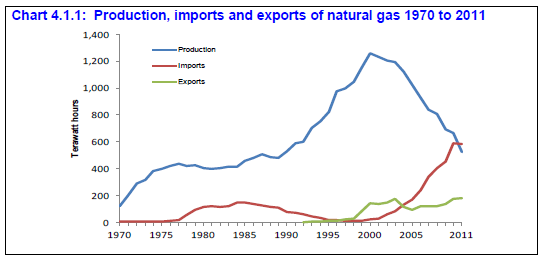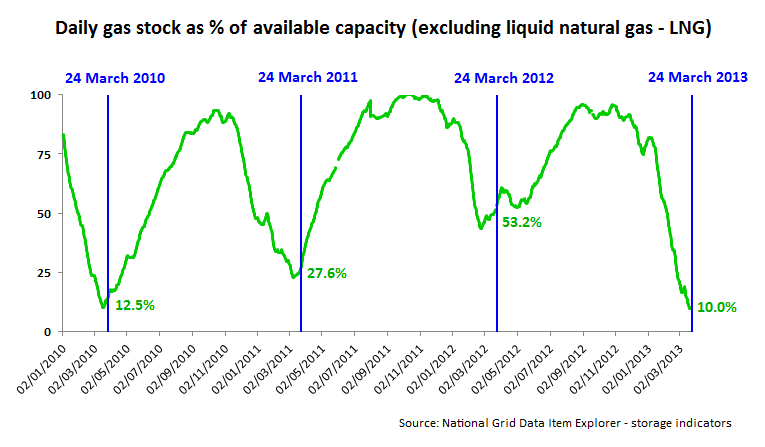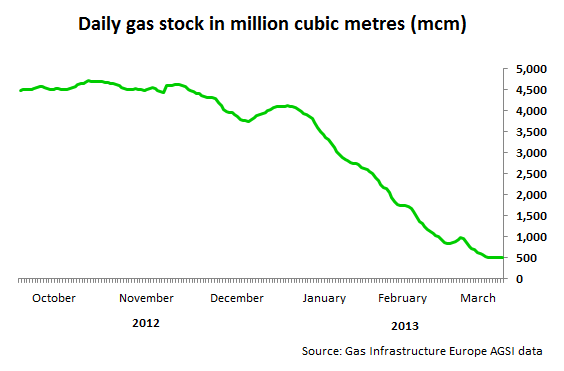Is the UK facing a 'gas crisis'?
Few of us need tables of data to tell us it's been a cold few days.
But the same may not be true about the state of the nation's gas reserves, which has been the subject of intense scrutiny in the media during this cold snap. A range of headlines and reports may well have caused concern recently that the UK's gas supply is on the brink of drying up:
Express: "Wrap up warm, British gas could run dry in less than TWO DAYS as bitter weather continues."
Sun: "Gas explosion: Price leaps 50% on fears Britain could run out."
Guardian: "Only two days' worth of gas supplies in storage late last week as cold snap increases demand for heating and electricty."
Mail: "The UK only has enough in storage to meet two days of demand."
Only two days of gas left? Observant readers will note that in spite of the continuing cold weather and at least two days having passed since most of these claims surfaced, the UK's gas supply remains intact. In fact, the mild hysteria in the newspapers is in stark contrast to the National Grid's announcement on Saturday that:
"Gas in storage is at levels that we would normally expect to see at this time of year."
So where do these headlines come from? An article published by the Reuters News Agency last Thursday seems to have sparked most of the UK coverage. The piece indeed stated:
"Britain is grappling with a potential gas supply crisis... Gas storage sites have been depleted by 90 percent, with the equivalent of less than two days' consumption remaining, data from Gas Infrastructure Europe shows."
'Gas Infrastructure Europe' is an association which "represents the infrastructure industry in the natural gas business". It regularly collects data on gas storage across Europe and helps us to make useful comparisons between countries.
At time of writing, it tells us that the UK currently has 502 million cubic metres (mcm) of gas in storage, out of a total of around 4,750 mcm (around 10-11%). This is where the reports get the idea that we're down to one tenth capacity. Not all gas is stored in one place, but instead over a number of locations across the UK, the largest being Rough - 18 miles off the Yorkshire Coast.
For context, in 2011 the UK produced around 50,000 mcm of gas and imported a further 39,000 mcm. Over the longer term, UK gas production has been declining steeply since the turn of the century, and as of about seven years ago we import more gas than we export:

Looking back at capacity, we can use the National Grid's Data Item Explorer to chart the UK's gas storage as a rough proportion of total capacity for the last three years:

The green line above demonstrates how our gas storage has drained over this winter. Although 10% is a recent historical low for this time of year, it's by no means unusual for gas storage to be depleted by this much toward the tail end of winter. The exception is the unusually warm March and April last year, when storage only reduced to about half of capacity.
The graph is also perhaps cause for optimism - this is normally the time of year that stocks start to pick up again, although with weather forescasters suggesting that we might not want to cast off our winter clothing just yet, we can't necessarily rely on this.
So do we only have two days left?
This claim was generated by Reuters themselves and comes from an analysis of the total daily demand for gas as measured by the National Grid. At the time of data extraction, Reuters placed this at around 270 mcm. Out of a storage of around 500 mcm, this is more than half.
In other words, if the UK's entire daily gas demand were to be met from storage, the supplies would last less than two days.
This is, however, an unrealsitic scenario. As the Department for Energy and Climate Change (DECC) has pointed out, the UK's gas supplies come from a number of different sources, not least pipelines leading to Norway and the Low Countries. Gas actually in storage is only one component of the UK's gas infrastructure.
For context, we can look at exactly how much gas has been leaving the storage stock, less gas entering. The following graph highlights the gas storage situation since October 2012:

Had the stock of gas continued to decline as rapidly as it did during January and February, storage may well have depleted by late March or early April - but this still doesn't mean the UK would have run dry, given the other sources of gas available to meet the increased demand during the cold weather. More recently, the outflows of gas have levelled off.
Conclusion
The UK does not have just two days of gas left, although for some the storage levels will have come worringly close to depletion. It's important to point out that storage is not be the only source of gas in the UK network and so it seems unlikely there would be a complete depletion of the UK's available gas were the stocks in storage to run completely dry.
However, UK storage levels have dropped to lower levels than elsewhere in Europe, although much of this will be due to the unusually cold March. Over the longer term, UK gas production is on the wane, and we're becoming more dependent on imports from abroad to keep our country fuelled.
In other words, headlines like these could be here to stay.